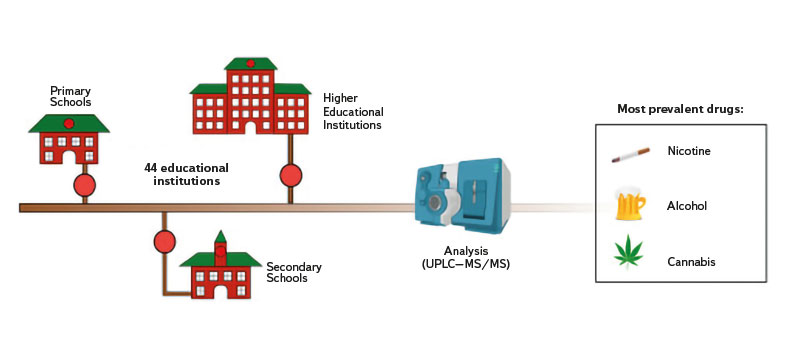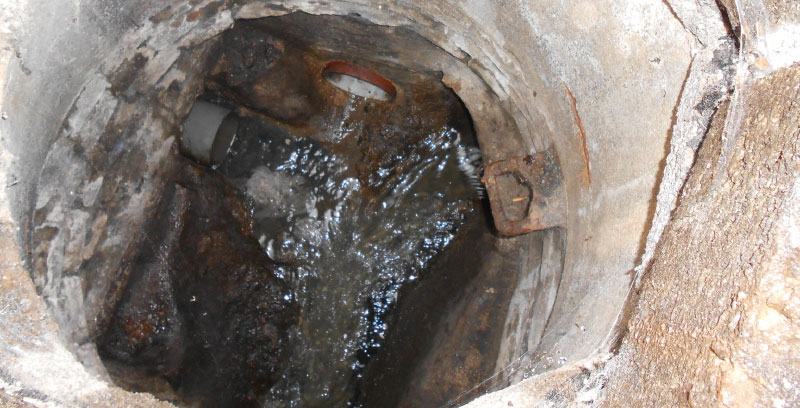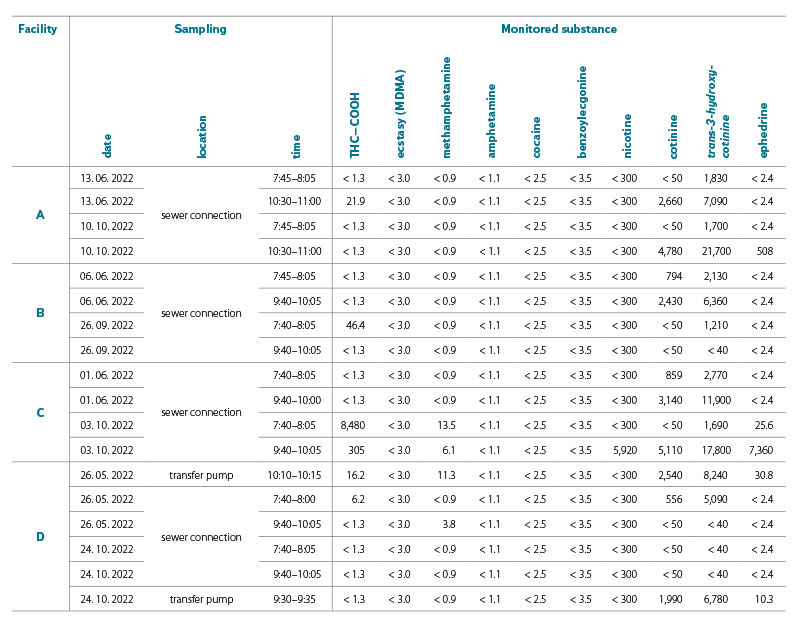ABSTRACT
The wastewater based epidemiology (WBE) approach to wastewater has long been used for monitoring drug consumption, especially in urban agglomerations. In this pilot project, it was applied to detect drug use in selected educational establishments. The tests took place in both primary (age 6–15) and secondary schools (age 12–19). The focus was on illicit drugs (marijuana, methamphetamine, amphetamine, cocaine, and ecstasy), as well as the licit drug nicotine and its metabolites. Ephedrine was also monitored. Grab samples were taken before the start of classes between 7:30 and 8:05 a.m., and during the so-called big break, i.e., between 9:30 and 10:00 a.m., or 10:30–11:00 a.m.
Sampling was carried out on two dates, at the beginning of June and at the end of September/beginning of October 2022. There were positive findings for THC, ephedrine, methamphetamine and nicotine metabolites, primarily trans-3-hydroxy-cotinine. In accordance with the possibilities of the pilot project, the number of monitored schools was very small. In order to objectively determine the situation in educational facilities, it would be appropriate to monitor a more representative group, which would include, for example, vocational schools. It is also worth considering another method of sampling wastewater, e.g., several hours’ composite samples. However, in many educational institutions, this method may not be feasible.
INTRODUCTION
The multidisciplinary scientific field of wastewater based epidemiology (WBE) has been applied for more than 20 years. It is a regular part of the detection of the consumption of licit and illicit drugs in the population, on which it has been focused since the beginning [1–3]. The results of the international monitoring of drug use in selected urban agglomerations are regularly published on the website of the European Monitoring Centre for Drugs and Drug Addiction (EMCDDA) [4, 5].
Today, municipal wastewater can provide comprehensive information about the health status of the population, the population’s exposure to environmental contaminants, diet, the occurrence of diseases, and the consumption of pharmaceuticals [6].
The Covid-19 pandemic greatly contributed to highlighting the importance of wastewater based epidemiology, as SARS-CoV-2 virus particles were excreted by the infected population into wastewater. Detecting these particles in wastewater and measuring their concentration can serve as a tool for early warning before the onset of the disease because these particles are excreted even before the typical symptoms of the disease [7, 8].
In addition to the now common monitoring of the consumption of selected licit and illicit drugs in urban agglomerations, their use can also be monitored in individual buildings in a similar way. Here, above all, an ethical approach is very important as it could very easily lead to stigmatization of the tested institutions [9, 10]. Through wastewater analysis, drug use has been monitored, for example, in prison facilities [11, 12], educational facilities [13–17], as well as at individual events (music festivals) [18].
In TGM WRI hydrochemical laboratories, samples and analyses have been carried out both in prisons and school facilities; therefore, the expert team has experience in this area. The results have generally not been published [19] for the above-mentioned ethical reasons, or because they are the outputs of commercial orders, to which TGM WRI does not have the default rule. The graphical presentation of monitoring is shown in Fig. 1, which was taken from [15].

Fig. 1. Graphical representation of monitoring in educational facilities (Source: [15])
METHODOLOGY
An accredited determination method, fully automated on-line solid phase extraction, and analysis by high-pressure liquid chromatography coupled with tandem mass spectrometry (on-line SPE and LC-MS/MS) were used to analyse illicit drugs in wastewater from selected school facilities, working in ESI + or ESI – mode (electrospray ionization), depending on the nature of the monitored substances. The method is based on procedure published by Postigo et al. [20]. In cooperation with the staff of the selected educational institutions, the possible sampling points were inspected. In one case, it was not possible to take samples for safety reasons (the sampling point was very difficult to access), so another facility was approached. In all selected schools, the sampling was carried out twice in the same year.
Wastewater sampling and analysis
Four schools from Prague and its immediate surroundings were selected for the pilot project: two primary schools and two secondary schools. Sampling was carried out at the sewage water outlet from the monitored facility (sewer connection); in one case, two sampling points were chosen due to the layout of the school. Fig. 2 shows an example of a sampling point. Sampling took place in June and in September/October 2022. These were grab samplings that were carried out in the morning after the school opened before the start of classes between 7:30 and 8:05 a.m. and during the so-called big break, i.e., at 9:30–10:00 a.m., or 10:30–11:00 a.m. The samples were transported to the laboratory immediately after collection and stored in a refrigerator at 4–8 °C; if it was not possible to process them within 48 hours after collection, they were kept frozen at -20 °C until the actual analysis.

Fig. 2. Example of a sampling point on a sewage connection (Source: TGM WRI archives)
The detailed procedure is described in [21]. After thawing and conditioning at room temperature, solid impurities were removed from the samples by filtration through membrane filters. A mixed solution of internal standards, including isotopically labelled standards, was added to the filtered sample. Furthermore, the samples were extracted, purified, concentrated on SPE column, and analysed by high-pressure liquid chromatography coupled to tandem mass spectrometry (on-line SPE-LC-MS/MS). The system worked in ESI + or ESI – mode depending on the type of analyte.
Marijuana was monitored in the samples through the standard analysed metabolite of THC, 11-Nor-9-carboxy-delta-9-THC (THC-COOH), i.e., the human metabolite and main excretory product of THC, which is the active substance of marijuana; these findings were as expected. Ecstasy (MDMA, 3,4-methylene-dioxy-methamphetamine) was also found, as were methamphetamine (Pervitin) and its metabolite amphetamine, cocaine and its human metabolite and the main product benzoylecgonine excreted in the urine, ephedrine, and nicotine and its metabolites cotinine and trans-3-hydroxy-cotinine. In the Czech environment, amphetamine is considered from the point of view of wastewater analysis primarily as a metabolite of methamphetamine, not as a drug used independently. THC-COOH was analysed by the on-line SPE-LC-MS/MS method in ESI – mode; the other substances were analysed by the on-line SPE-LC-MS/MS method in ESI + mode. The measured results (chromatograms) were subsequently evaluated by the corresponding instrument software and manually checked by the analyst.
RESULTS AND DISCUSSION
Due to the limited possibilities of this pilot project, samples were taken only in four facilities. Tab. 1 summarizes all measured results. For ethical reasons, the results are presented anonymously. Facilities A and C are secondary schools (age 12–19), facilities B and D primary schools (age 6–15). The number of pupils in the schools varies between 500 and 1,000. The results are given in concentrations (ng/l) and cannot therefore be compared with each other. Wastewater flows were not measured at the time of sampling. Therefore, it is not possible to express the results as, for example, ng/day/1,000 inhabitants. Nevertheless, it is possible to conclude whether drugs are a problem in the monitored school.
Tab. 1. Complete results of selected drug monitoring in educational facilities

We assumed that marijuana would be the most commonly abused drug. It was analysed in all monitored facilities, but not in all samples. The highest concentrations of this drug were found in facility C, but only in the sample taken on 3rd October 2022. It is possible that the date of the first sample (1st June 2022) was not chosen appropriately because on this day (Children’s Day) some schools had special programmes. In other schools, much lower concentrations were found, and always only in one sampling at one sampling point. Ecstasy (MDMA) was not present in any sample, nor was cocaine and its major human urinary metabolite benzoylecgonine. Methamphetamine (Pervitin) was found in a total of four samples from facilities C and D, in single to double digits of ng/l. Amphetamine was also not present in any of the analysed samples. It fully corresponds to the fact that, in the Czech Republic (from the point of view of wastewater analysis), amphetamine is considered a metabolite of methamphetamine, and at the concentrations of methamphetamine found, the amount excreted is below the limit of quantification of the method used.
Metabolites of the licit nicotine drug cotinine, and especially trans-3-hydroxy-cotinine, were found in almost all monitored samples. In this case, however, it can be assumed that school employees contribute a significant share of the excreted amounts.
In total, ephedrine was determined in five wastewater samples. Ephedrine is a precursor for the production of Pervitin, but it is also part of flu and cough preparations, as it relaxes the airways and relieves flu symptoms. In combination with caffeine, it is an excellent fat burner. It is also used as a weight loss medication and is part of preparations designed to build muscle and improve the physical abilities of athletes [22]. It is a prohibited doping substance. In the building of the school facility where the highest concentrations of this substance were measured, the fitness centre is open to the general public from early in the morning, so the visitors of this centre may therefore be mainly responsible for the high concentration of ephedrine in the wastewater.
Due to the small number of samples, no statistical evaluations can be performed; however, it was not the goal of this very small-scale pilot project.
When comparing the findings obtained in the project with the findings in other monitored schools as part of commercial contracts implemented before, it can be stated that, with a high probability, drug consumption does not represent a significant problem in the educational facilities tested in the project. Only in the facility C would it probably be appropriate to pay more attention to drug issue. However, the measurement would need to be repeated.
The results are difficult to compare even with the references. Zuccato et al. [13] report results in mg/day/1,000 inhabitants, while other authors [14, 17] monitor universities; Verovšek et al. [15] are only concerned with the identification of drugs in the wastewater of the tested schools. The only comparison is thus offered by another publication by the authors cited above [16], which contains the results of the research of drug abuse in 44 school facilities in Slovenia. For example, in primary schools in urban areas, the concentration of THC-COOH ranges between 4.44 and 1,460 ng/l; the main cocaine metabolite benzoylecgonine (28.8–1,640 ng/l) was also determined in a number of schools. Ecstasy was not found in any of the primary schools, nor was methamphetamine. In the case of benzoylecgonine and methamphetamine, there is a difference between Czech and Slovenian schools. In Czech schools, benzoylecgonine was not found in any case, but methamphetamine was detected in one case.
If this pilot project were to be followed up by another, more extensive project, in which it would be possible to involve other types of educational facilities (e.g., apprenticeship and vocational schools as well as higher vocational schools), it would be appropriate to verify another sampling method (e.g. collection of several hours’ composite samples) and, simultaneously, to determine wastewater flows at the time of sampling. Then the results could be better compared with each other. It would also be interesting to increase the frequency of sampling in individual facilities, or to monitor one sampling point, for example, for a whole week.
It would be interesting to add mitragynine (the active alkaloid of kratom) to the monitored substances; due to its easy availability and widespread use among young people, it is currently receiving a lot of attention from addictologists.
CONCLUSION
The pilot project fulfilled its purpose. We verified the entire procedure required for the collection and analysis of wastewater from educational facilities, from the selection of facilities, communication with their management, on-site inspection, and selection of a suitable sampling point on the sewer connection, including possible consultation with workers operating the sewer network. In older buildings in particular it is not always easy to find a sampling point. In all tested schools, drugs were found in measurable quantities, mostly only occasionally. In accordance with the assumption, it was mainly marijuana. Methamphetamine was found in two schools in concentrations that were similar to most schools tested by the TGM WRI hydrochemical laboratories as part of commercial contracts.
The licit drug nicotine and/or its metabolites cotinine and trans-3-hydroxy-cotinine were determined in almost all samples. Comparison with previous analyses is not possible because it was only later included in the analytical method of determination. Similarly, we do not have the possibility to compare the findings of ephedrine. Ephedrine is part of over-the-counter cold medicine, but it is also part of preparations used to build muscle and improve the condition of athletes. As one of the tested schools has a publicly accessible fitness centre open from early in the morning, and it is not possible to ensure sampling at the sewer connection so that sewage from the fitness centre is not part of the sample taken, it can be assumed that visitors to the centre significantly contributed to the finding of high concentrations of ephedrine in the sample.
When selecting school facilities for a possible future project, it is therefore necessary to pay attention to whether extracurricular activities intended for the general adult public (lifelong learning, language courses, exercise courses, etc.) could significantly influence the findings of tested substances in wastewater.
Acknowledgements
The pilot project was financed from the institutional resources of the MoE within the internal grant TGM WRI No. 3600.52.22. We thank the participating educational institutions and their management for agreeing to conduct the testing and for their cooperation. For ethical reasons, these institutions are not mentioned by name. It would not be possible to carry out the sampling without the involvement of Ing. Josef Kratina Ph.D., Ing. Ondřej Taufer, and Mr. Vojtěch Mrázek.
This article was translated on basis of Czech peer-reviewed original by Environmental Translation Ltd.
